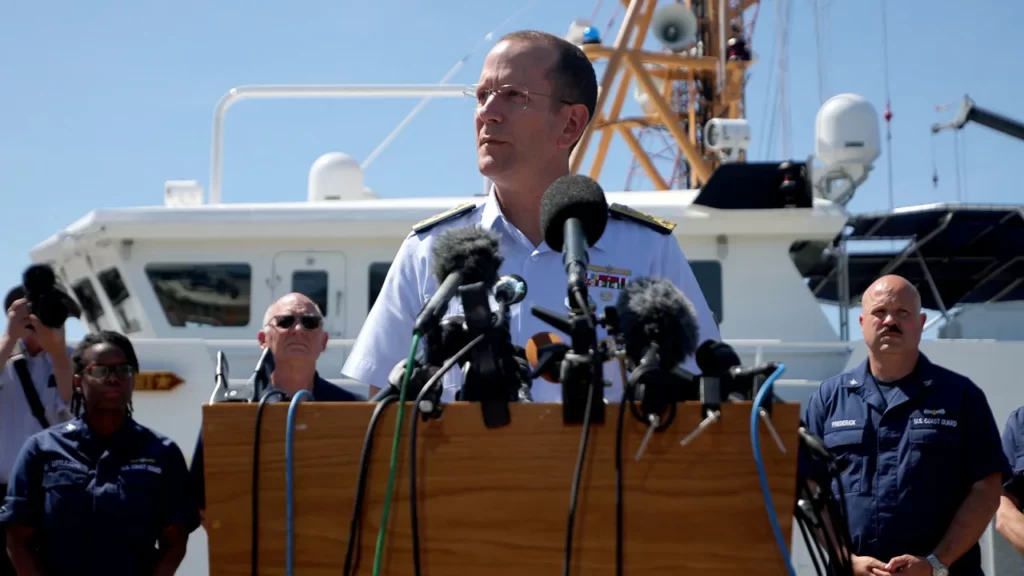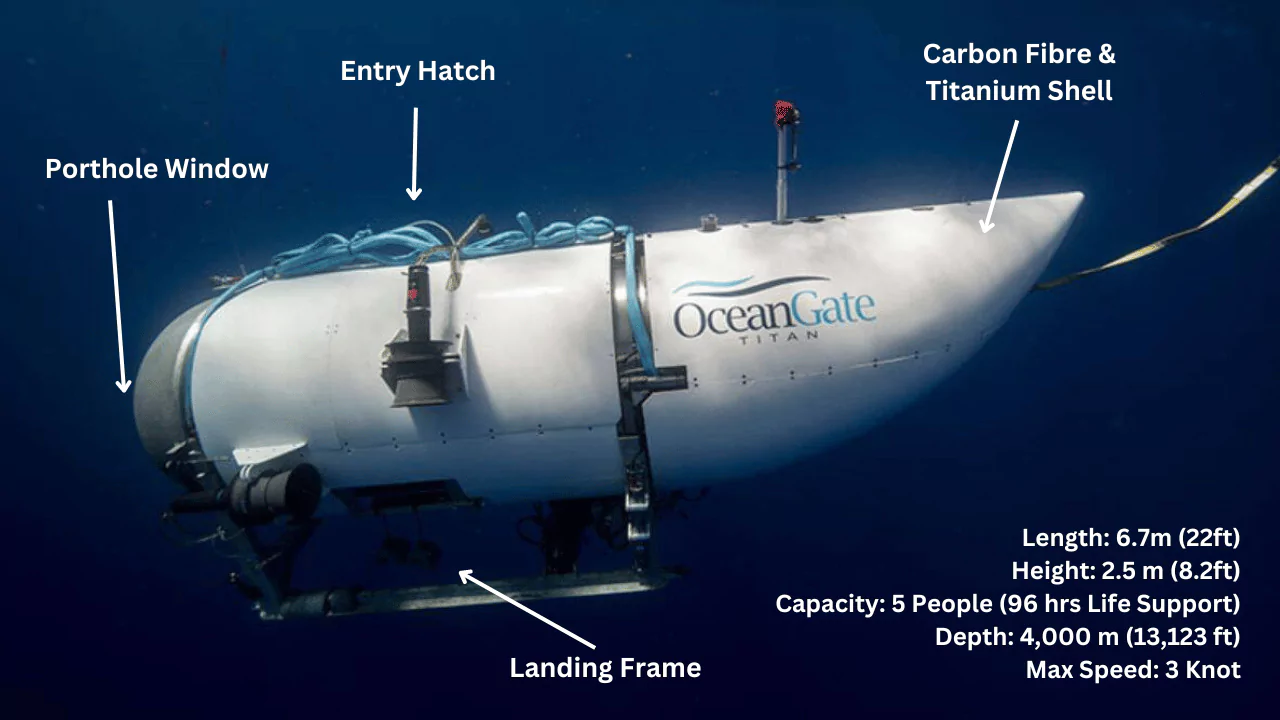The 2023 Titan Submersible Incident has shaken the world of deep-sea exploration, as the cutting-edge submarine vanished during a daring expedition to explore the remains of the RMS Titanic in the North Atlantic Ocean.
This tragedy underscores both the marvels and dangers that lie beneath our oceans’ surface, impacting not only those aboard but also their friends, family, and colleagues worldwide.
With key figures such as SETI Institute trustee Shahzada Dawood and Ocean Gate CEO Stockton Rush among its passengers, this catastrophe highlights pressing concerns about underwater safety measures and technology used for oceanic research.

Key Takeaways
- The 2023 Titan Submersible Incident resulted in the loss of all five crew members during a mission to survey Titanic’s remains, highlighting the importance of adhering to proper safety protocols during deep-sea exploration.
- Search and rescue operations at extreme depths present significant challenges that require enhanced emergency response capabilities and international cooperation.
- Technology advancements equipped with robust safety features are necessary for reducing hazards associated with underwater explorations.
- Identifying the root causes and contributing factors behind such incidents can help prevent similar tragedies in the future by improving risk assessment measures, safety protocols, and technology used in submersible operations.
Understanding The 2023 Titan Submersible Incident
The 2023 Titan Submersible Incident refers to the disappearance and subsequent implosion of the submersible vehicle during a tourist expedition to explore the remains of the RMS Titanic in international waters of the North Atlantic Ocean, resulting in a devastating loss of human life.
The Disappearance And Implosion
On a fateful mission to explore the underwater wreckage of the Titanic, the Titan submersible suddenly vanished without a trace. All five crew members on board, including a British adventurer, a Pakistani billionaire father and his son, an expert on the Titanic, and OceanGate’s own CEO are now presumed dead due to an unexpected and catastrophic implosion.
Investigations led by the US Coast Guard attempt to unravel the mystery behind this tragic occurrence while multinational search efforts continue in challenging underwater terrain and unfavorable weather conditions.
The Devastating Human Toll
The 2023 Titan Submersible Incident undoubtedly left an indelible mark on the world of underwater exploration, as it claimed the lives of all five passengers onboard. The tragic accident not only shocked the maritime community but also generated widespread global sympathy for those who perished.
The fateful expedition was focused on exploring the remains of the Titanic at a depth of 12,500 feet when disaster struck. The submersible experienced an unforeseen catastrophic implosion that led to their deaths.
As governments worldwide expressed condolences – including messages from UK and Indian leaders – OceanGate officially confirmed these losses among its crew members with profound grief.
In addition to mourning this heartbreaking loss, investigators now face immense challenges relating to search operations amid treacherous deep-sea environments where even advanced technology struggles against various hazards.
Consequently, there is considerable concern about whether recovery efforts can be successful or if they will eventually transition into salvage missions instead.
The Challenge Of Search And Rescue Operations
The 2023 Titan Submersible Incident presented one of the most formidable challenges for search and rescue operations in recent history. Conducting such a mission at extreme depths in the North Atlantic, where the RMS Titanic wreckage lies, requires specialized skills, equipment, and international cooperation.
In this complex case, multiple countries including Canada, France, and the US joined forces with various organizations to deploy cutting-edge marine technology such as deep-sea diving robots and pinger locators.
Despite these efforts and leveraging advanced tools like roving robots designed for abyssal exploration, navigating through an immense search area under intense pressure remains incredibly challenging.
The Hazards Of Deep-Sea Exploration
Deep-sea exploration is fraught with hazards due to the mysterious and dangerous deep-sea environment, emphasizing the importance of proper safety protocols, improved technology, and emergency response capabilities.
The Mysterious And Dangerous Deep-Sea Environment
The deep-sea environment is a mysterious and dangerous place. It is the largest habitat on Earth, covering more than 60% of the planet’s surface. This area of ocean water extends beyond 200 meters from the coastline and goes as deep as 36,000 feet (11 km) in some places.
There are many hazards associated with deep-sea exploration including oxygen deprivation, underwater pressure changes, extreme temperatures, and deepsea debris fields created by natural disasters or human activities.
Despite these dangers, researchers continue to explore this unique ecosystem because it offers critical insights into marine biology research and other aspects of our planet’s history such as geological formations like oceanic trenches.
The Importance Of Proper Safety Protocols In Deep-Sea Exploration
Proper safety protocols are essential in deep-sea exploration, as highlighted by the 2023 Titan Submersible incident. The hazards of deep-sea exploration, such as pressure and temperature extremes and underwater topography dangers, make it crucial to adhere to strict safety measures.
Trained professionals must follow proper procedures to reduce risks associated with submersible operations.
Investment in safety measures should continue to be a significant consideration for anyone venturing into undersea expeditions because the resources and technology required for safe deep-sea exploration call for considerable investment in research, development, training, and potential accident remediation activities.
The Need For Improved Technology And Emergency Response Capabilities
The 2023 Titan Submersible Incident highlighted the need for improved technology and emergency response capabilities in deep-sea exploration. The devastating incident resulted in the loss of a submersible and all five crew members during a mission to survey the remains of the Titanic.
Effective search and rescue operations require better safety protocols, contingency plans, and emergency response measures to mitigate potential risks associated with deep-sea exploration.
Due to remote locations and hazardous conditions, search and recovery operations present unique challenges that require enhanced emergency preparedness abilities. International cooperation is also critical when responding to maritime disasters such as this one involving Canada, France, and the US.
Learning From The Tragedy
We must identify the root causes and contributing factors of the 2023 Titan Submersible Incident to prevent similar tragedies in the future.
Identifying The Causes And Factors Contributing To The Incident
The 2023 Titan submersible incident was a tragic event that shocked the world. Identifying the causes and factors contributing to the incident is crucial for both its victims’ families and deep-sea exploration’s future safety.
Currently, investigations are underway by multiple organizations, including the US Coast Guard.
Experts have suggested several reasons that might have caused this disaster- from human errors to technical malfunctions. The extreme pressures at such depths could also be an issue as they can cause equipment failure or structural damage to vessels.
Regardless of what led up to this tragedy, identifying its root causes will help prevent similar incidents in the future through enhanced risk assessment measures, better safety protocols, and improved technology used in deep-sea exploration operations.
Understanding these underlying issues is paramount not only for submersible operators but also for remote-operated vehicles (ROVs) commonly used in offshore oil rigs or marine research projects worldwide.
Lessons Learned And Implications For Future Submersible Operations
The 2023 Titan submersible incident has taught us some valuable lessons. Here are some of the key takeaways and implications for future submersible operations:
- Safety protocols must be a top priority during any deep-sea mission.
- Risk management measures need to be in place to mitigate potential hazards.
- Emergency response plans must be developed and tested regularly.
- Proper hull design is crucial, and any potential weaknesses should be identified and addressed.
- Improved technology should be developed to aid in deep-sea exploration and enhance safety measures.
- The importance of thorough training for all crew members involved in submersible operations cannot be overstated.
- Regular maintenance and inspections of equipment should be conducted to identify any potential issues before they become critical.
- Swift, coordinated responses from multinational organizations can increase the chances of survival in emergency situations.
These lessons learned from the 2023 Titan submersible incident should guide future deep-sea research endeavors as we seek to advance science while ensuring the safety of all involved.
Call To Action For Enhanced Safety Measures
The Titan Submersible Incident has highlighted the crucial need for enhanced safety measures in deep-sea exploration. The tragic loss of life and the implosion of the submersible have raised questions about the safety protocols, technology, and emergency response capabilities used in underwater research.
It is important to learn from this tragedy and take steps to prevent similar incidents from happening in the future. This includes improving equipment designs, developing new technologies that can withstand extreme conditions, increasing training programs for crew members, adopting stricter safety regulations across industry suppliers or vendors involved in submarine manufacturing like dive equipment manufacturers like Bonex, and investing more resources into search and rescue operations.
The Future Of Deep-Sea Exploration
Advancements in marine technology and emergency response capabilities must be pursued to ensure safe and sustainable deep-sea exploration, while also honoring the victims of tragic incidents like the 2023 Titan Submersible Incident.
Balancing The Rewards And Risks Of Deep-Sea Research
Deep-sea research provides a wealth of knowledge about our oceans and marine life, but it also comes with inherent risks. The 2023 Titan submersible incident during an exploration mission of the Titanic wreckage is a tragic reminder of these dangers.
While the cause of the implosion that led to the loss of all five people on board is still being investigated by the US Coast Guard, this event highlights how crucial it is to balance rewards with risk in deep-sea research.
Investing in adequate safety protocols and technology can help improve emergency response capabilities and minimize potential hazards.
Advancing Science And Technology In A Safe And Sustainable Manner
Advancing science and technology in a safe and sustainable manner is crucial for the future of deep-sea exploration. The risks associated with exploring the depths of the ocean are immense, making safety protocols an absolute necessity.
In order to minimize these risks, it’s important that advancements in both the technology used for deep-sea exploration, as well as emergency response capabilities continue to be made.
In addition to safety concerns, sustainability must also be considered in all aspects of deep-sea exploration. With proper planning and execution, marine resources can be utilized without causing permanent damage to fragile ecosystems or species populations.
Honoring The Victims And Moving Forward

As we reflect on the tragic events of the 2023 Titan Submersible Incident, it is important that we honor the victims and their families. Losing five crew members in this incident is a devastating loss for everyone involved in deep-sea exploration.
The multinational efforts to locate the missing submersible and its occupants highlight how challenging such search and rescue missions can be.
Moving forward, improving safety measures in deep-sea exploration should be a top priority. With advancements in technology like sonar equipment, there is potential for more efficient search and rescue operations in future incidents.
However, the risk assessment must always come first before undertaking any underwater research or expeditions. We need to ensure that all necessary precautions are taken before diving into potentially dangerous environments so as not to repeat mistakes from past incidents like this one.
Conclusion
The 2023 Titan Submersible Incident was a tragic event that highlights the risks and rewards of deep-sea exploration. The loss of five lives is a reminder of the importance of proper safety protocols in this field.
As we move forward in oceanic research, there is an urgent need for improved technology and emergency response capabilities to ensure the safety of all those involved.
By learning from this tragedy, we can identify the causes and factors contributing to such incidents, ultimately leading to enhanced safety measures.



